Atelier Bonryu(E)
zone plate photography


Atelier Bonryu(E)
zone plate photography


Laboratory: Zone Plate Photography
Taking Zone Plate Photographs
- Background Light, Halo, Fog -




Background light: We described that the background light affects the appearance of a zone plate photograph and by removing it a unblurred photograph can be attained. In this page we describe the background light in more detailed manner. But to avoid an elaborate detail the quantitative discussion is described in the Remark page (*5). By the way, though a term, a “background light” is usually used for a light coming from an object other than the targeting one or an ambient light, in this web page it means the directly coming light without suffering deflection at transparent zones. In the following we summarize a halo around an object and a fog due to the background light. Though the light which forms an image of an object is the diffracted light passing through the transparent zones, there are a large quantity of light which are not deflected at the transparent zones and proceed forward. Even when lights are emitted from the same point on the surface of the photogenic object these lights interfere each other. For interference of lights the lights should be coherent, i.e., phases of the lights must be same each other. Incoherent lights become the background lights which are shown as in the following figure.
Halo and fog due to the background light
The light from a point on the surface of a photogenic object is diffracted at a transparent zone and arrives at the focal point and forms an image of the object, where the light coming through the central zone and all the lights diffracted at transparent zones are synchronous in phase. This is the image of the object expressed by deep green in Figure (a) . On the other hand the light which does not deflect at the transparent zone forms a halo around the image of the object. This is an pale green image in Figure (a). The distributions of brightness along the dotted line are shown for photographs taken by a usual camera with a glass lens and a zone plate camera, respectively, in Figures (b) and (c). In a zone plate photograph a halo due to the photogenic object itself and a so-called “fog” due to an ambient light are seen. In the previous page we described a method to make a zone plate photograph unblurred by taking off the fog (background light due to the ambient light).
Halo and fog: By the way how large and how bright is a halo? Though it is described in remark *5 in a little more detail, the following figures may give an intuitively understandable idea. In the following discussion it should be noted that the size is measured on the image plane. The SLR camera I use is of the four-thirds format and the diagonal of the image sensor is about 21 mm. Because the distance between a zone plate and an image sensor is, usually, far shorter than the distance between the zone plate and a photogenic object, the radius of the area at which the background light arrives is approximately the same as the radius of the outermost transparent zone. Therefore, the width of a halo around an image of the object is considered to be about the same as the radius of the outermost transparent zone. As for the brightness of a halo, if the size of the image of the object is very small the halo is dark. And the brightness increases with increasing the size of the image until the image size becomes comparable with the zone plate size. Even when the size of the object is increased further the brightness of the halo remains almost constant. These are illustrated in the following figures. As an “image” produced by an ambient light is considered to be an image of a very large object, a background light due to this object is bright and pervasive over the photograph. We call the “image” by this background light as a fog.
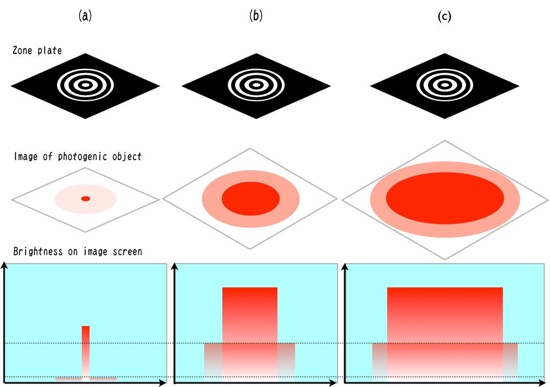
Relation between the image size and the brightness of halo.
From the left to the right the size of the image of the object becomes larger. The brightness of the halo increases with increasing the radius of the image until it becomes about a zone plate size but afterward it remains nearly constant. When the image is considered as that of the ambient light this halo is considered as a fog.
Examples: In the following we explain a relation between the halo and the clearness of a zone plate photograph by looking at actual photographs. For this purpose we prepared a photograph taken by a pinhole optimized for the focal length of 55 mm, photographs by zone plates with focal lengths of 55 mm and 300 mm. Photographs by the zone plate with a focal length of 55 mm and the number of zones of 29 are the same ones used in the previous page. The zone plate with a focal length of 300 mm and a number of zones of 65 is used to take the moon. Though craters of the moon cannot be resolved finer object than the size of the central zone can be identified.

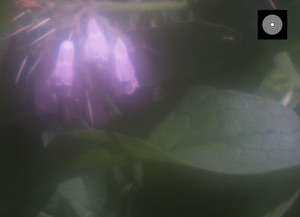

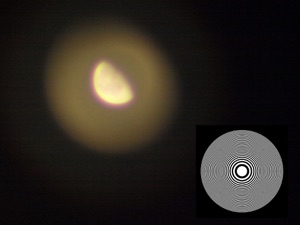
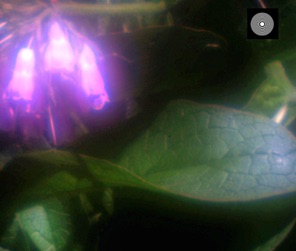
Pinhole photograph
The left picture of comfrey is a pinhole photograph taken for comparison. A small white circle at the upper right corner shows the size of the pinhole on the image sensor. The size is optimized with respect to a focal length of 55 mm. Leaf veins are not clear because width of the veins is thinner than the pinhole size.
Zone plate photograph (f=55 mm)
These three pictures are photographs of a comfrey taken by a zone plate with a focal length of 55 mm and zone number of 29. The size of the zone plate on the image screen is shown at the upper right corner of each photograph. The upper left picture is the photograph as it was taken. The upper right picture is a photograph after the level adjustment, where detailed structures of flowers and leaf veins are more clearly seen in comparison with the pinhole photograph. After the level adjustment the zone plate photograph is finished by the pseudo-HDR process which is explained in the next page (the right photograph). The structures of the flowers and the leaf veins become clearer and one can distinguish the separation of the leaf vein which is shorter than the diameter of the central zone of the zone plate.
Zone plate photograph (f=300 mm)
The moon was taken by a zone plate with a focal length of 300 mm and the number of zones of 65. It is found that the width of the halo is about the same as the radius of the zone plate.
As shown by the above examples it is possible to take a zone plate photograph with a high resolution. A fog by a light from the background can be removed substantially making the photograph rather clear with leaving a halo around the object, where an attractive feature of the zone plate photograph remains as it is. As in the zone plate photography there are a lot of adjustable parameters in comparison with the pinhole photography various interesting zone plate photographs can be taken by exercising ingenuity. For example, there are choices of changing the focal length or the number of zones, the Fresnel type zone plate or the Gabor type zone plate, and there are also choices of the photon sieve and the fractal zone plate which minimizes the chromatic aberration.
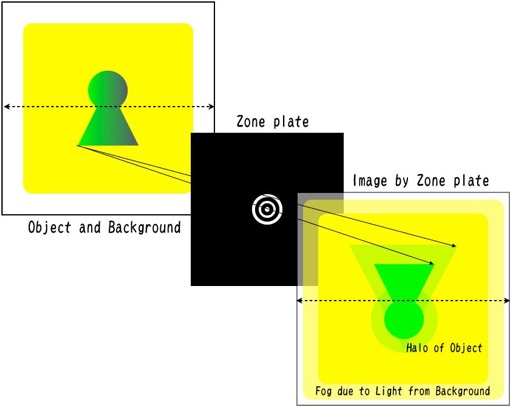
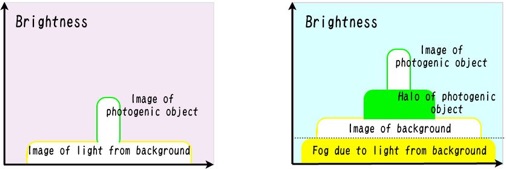
(a)
(b)
(c)
